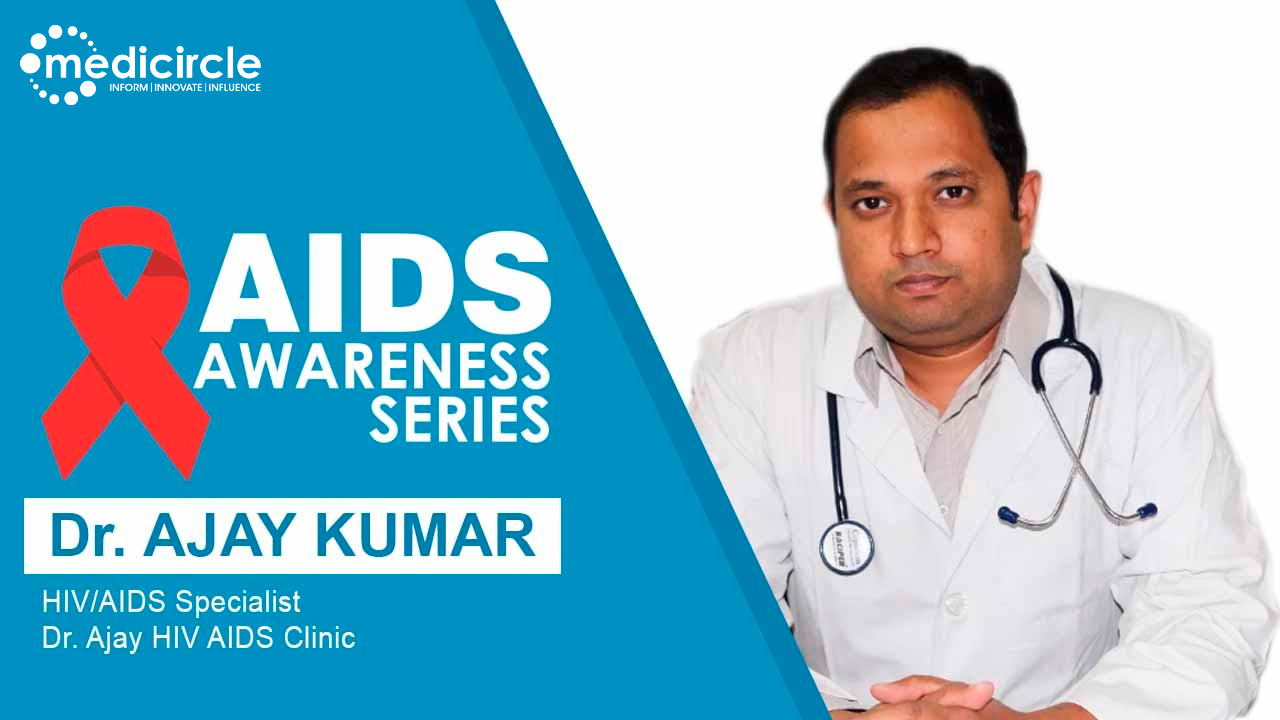India has the third-largest HIV epidemic with 2.35 million people living with HIV. Of this 1.345 million are receiving ART. There were 69,220 new HIV infections and 58,960 AIDS-related deaths reported in India in 2019. India’s HIV epidemic is driven by sexual transmission. The three states with the highest HIV prevalence, Manipur, Mizoram, and Nagaland, are in the east of the country. India’s HIV epidemic is slowing down. Between 2010 and 2017 new infections declined by 27% and AIDS-related deaths more than halved, falling by 56%. We at Medicircle are conducting interviews with some prominent specialists/ doctors to be aware of this problem of prostate cancer which will help you deal with it.
Dr. Ajay Kumar is Working as a General physician for the past 17 years. He has carved a niche of his own in and around Narayanguda, Hyderabad. Apart from being a general physician, he is a renowned HIV specialist and Chest Physician who received his MBBS and MD from the prestigious Osmania Medical College, Hyderabad in 1999 and 2005 respectively. He received his FHM fellowship in HIV medicine from CMC Vellore in 2009.
HIV is a STD
Dr. Ajay expresses, “HIV is a Sexually Transmitted Disease. Generally, we classify HIV into STDs. Besides HIV, STDs comprise other diseases like syphilis, gonorrhea, etc. HIV is the most dangerous of all STDs because it cannot be completely cured, the patient has to take treatment for lifelong by which disease remains under control. STDs like syphilis, gonorrhea have got a cure. STDs other than HIV often present with some specific symptoms but HIV shows no specific symptoms, so it is difficult to diagnose. Therefore, STDs is a broad term that includes many diseases and HIV is also a kind of STD.
HIV - Modes of transmission
Dr. Ajay says, “Basically, HIV can be transmitted in many ways. The most common way of transmission is through sexual exposure. Other less common modes of transmission are the use of unsterile injections, patients receiving a blood transfusion during surgeries or other treatments, and from pregnant mother to her baby.
Why AIDS is a syndrome ?
Dr. Ajay mentions, “There are no specific symptoms or signs of HIV. It generally presents with numerous signs and symptoms. Some patients come with motion, diarrhea, while others experience fever, cough, or lymph nodes enlargement. So, there are several signs and symptoms which cannot be included in a single bracket. Hence, AIDS is called a syndrome and not a disease.
HIV Prevention
Dr. Ajay stresses, “The awareness regarding HIV prevention is very low among the general public. Here’s some pre-exposure and post-exposure prophylaxis, for prevention from HIV.
Pre-Exposure Prophylaxis – If a person is planning to make a sexual relationship, then he/she should take this drug (PrEP) before sexual contact to prevent HIV. It is a kind of preventable method.
Post Exposure Prophylaxis – If a person has gone through unprotected sexual activity, then he/she can take this drug within 72 hours of sexual exposure and should continue taking this for 1 full month. It is also a preventive aspect for HIV.
If a pregnant woman is HIV positive, medicine can be given to the expectant mother (in early trimesters) to suppress the viral load, making her unable to transmit the infection to the baby.
Discordant couple (Couple in which one is HIV positive and the other is HIV negative) – These couples should always use protection for sexual activity. In case they (protection) fails, then they can also take PrEP (before making sexual relations) or PEP (after getting sexually exposed) drugs to prevent HIV.
(Edited by Renu Gupta)

 Dr. Ajay Kumar gives an overview of HIV AIDS. HIV is a Sexually Transmitted Disease. The most common way of transmission is through sexual exposure. Awareness regarding HIV prevention is very low. Here are a few simple ways by which one can easily prevent HIV infection.
Dr. Ajay Kumar gives an overview of HIV AIDS. HIV is a Sexually Transmitted Disease. The most common way of transmission is through sexual exposure. Awareness regarding HIV prevention is very low. Here are a few simple ways by which one can easily prevent HIV infection.





.jpeg)
.jpeg)

.jpeg)
.jpeg)
.jpeg)
.jpeg)
.jpeg)
.jpeg)
.jpeg)





.jpeg)



.jpeg)
.jpeg)







.jpg)

